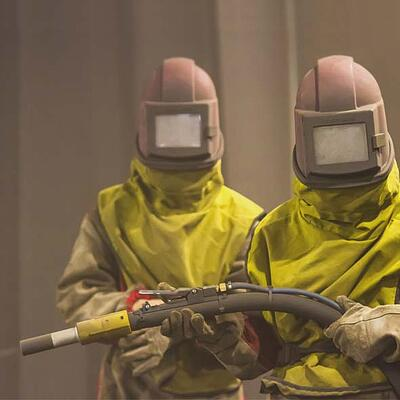News
How Adjusting Abrasive Blasting Equipment for Maximum Performance?
21/2/2023
Using properly adjusted and maintained abrasive blasting equipment and correct grit blasting techniques can reduce your blasting time and increase the quality of the finished surface.
Measure air pressure at the nozzle, rather than at the compressor, because there will be an unavoidable drop in pressure between the compressor and the nozzle, especially when you use long hose lengths.
Measure nozzle pressure with a hypodermic needle gauge inserted into the blast hose, directly before the nozzle.
A rough guide to sizing is that the blast hose diameter should be between three and five times that of the nozzle. Hose lengths should be kept as short as site conditions will allow and correctly sized couplings fitted to avoid unnecessary pressure loss throughout the system.
5. Check your abrasive metering valve.
The metering valve is a critical part of the abrasive supply to the nozzle. This valve precisely controls the amount of abrasive introduced into the airstream.
Excess abrasive causes the particles to collide with each other, reducing velocity and ultimately affecting the quality of finish.Too little abrasive will produce an incomplete blast pattern resulting in reduced productivity because of some areas needing a redo.

1. Use the correct air pressure for abrasive blasting.
Optimum abrasive blasting pressure is at least 100 psi. If you use lower pressures, productivity will almost certainly be reduced.Measure air pressure at the nozzle, rather than at the compressor, because there will be an unavoidable drop in pressure between the compressor and the nozzle, especially when you use long hose lengths.
Measure nozzle pressure with a hypodermic needle gauge inserted into the blast hose, directly before the nozzle.
2. Use the correct blast hose for the job.
Always use good quality blast hose and select the correct diameter to minimize friction losses.A rough guide to sizing is that the blast hose diameter should be between three and five times that of the nozzle. Hose lengths should be kept as short as site conditions will allow and correctly sized couplings fitted to avoid unnecessary pressure loss throughout the system.
3. Use the correct blast nozzle.
The size of the blast nozzle orifice will affect the productivity of the blasting operation. The larger the bore, the bigger the area blasted, facilitating faster production rates,there needs to a balance between compressor, hose and nozzle sizes. Regularly inspect blast nozzles and replace them if necessary. The nozzle liner will become worn over time and the resultant increased orifice size will require more air in order to maintain nozzle pressure and abrasive speed.4. Check your air supply.
You need a cool, dry air supply to transport the abrasive through the blast hose and propel it onto the surface to be cleaned. Damp air can cause agglomeration of the abrasive and blockages in the hose. It can also cause moisture to condense on the substrate, leading to possible coating failure due to blistering.5. Check your abrasive metering valve.
The metering valve is a critical part of the abrasive supply to the nozzle. This valve precisely controls the amount of abrasive introduced into the airstream.
Excess abrasive causes the particles to collide with each other, reducing velocity and ultimately affecting the quality of finish.Too little abrasive will produce an incomplete blast pattern resulting in reduced productivity because of some areas needing a redo.


professional firm engaged in the research, development, sale, and service of Steel Shot, Steel Grit, sandblaster, sandblasting machine, garnet sand. We are located in Jinan with convenient transportation access. .
Quick links
Products Structure
Our Contacts
No.365 ,The Second Jing Road ,Huaiyin District, Jinan City ,Shandong Province ,China
0086-531-82020205
+0086-15806668333

